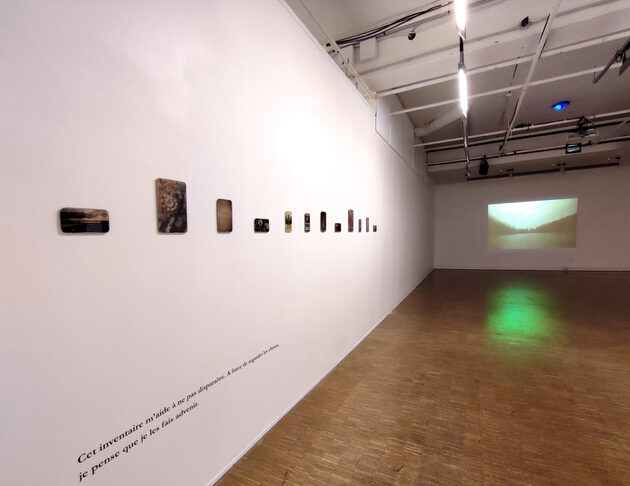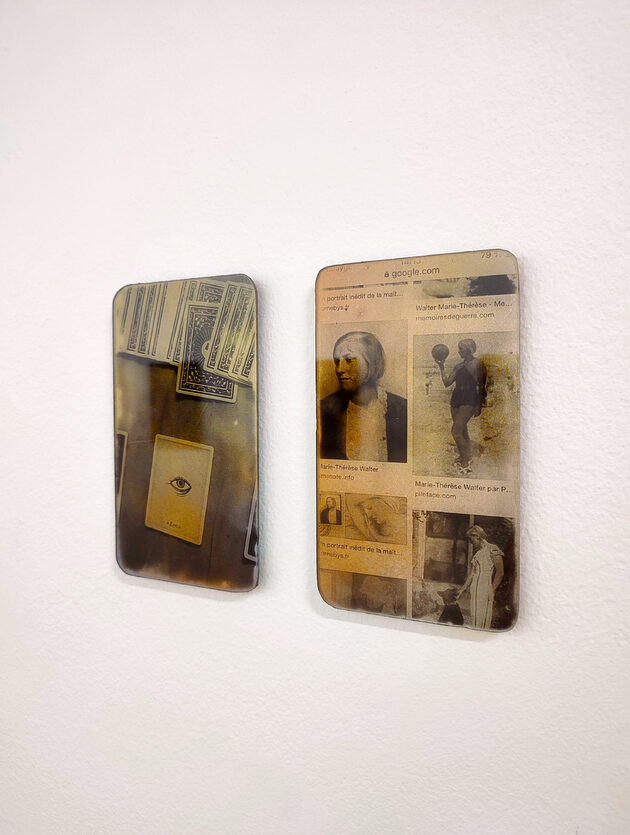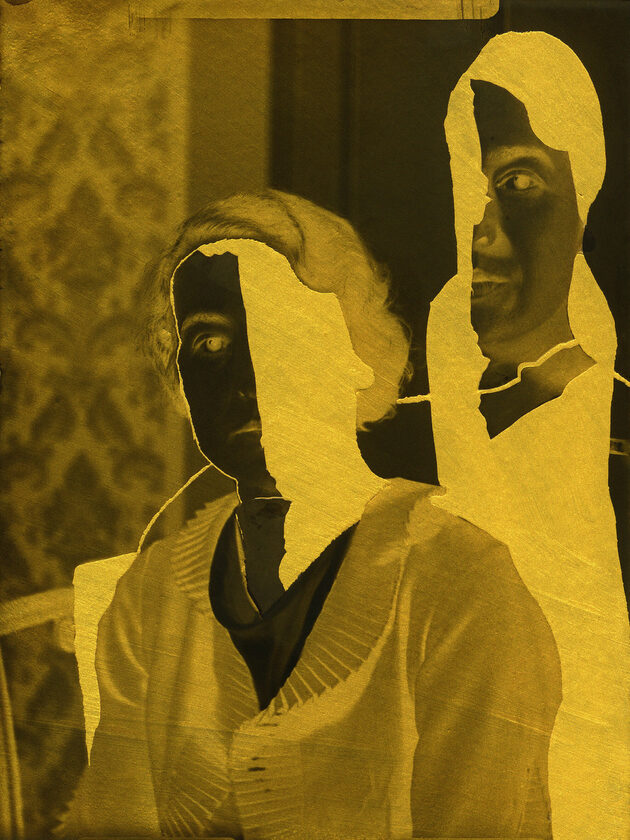The surprisingly sober course of relics of days, Anaïs Boudot’s solo show opens the gallery’s season 22/23. Without any desire for sensationalism in the subjects, the artist’s images evoke the plasticity of the photographic material and her memory capacity. A notable point of this exhibition is the presentation of his series The forgottena statement for women’s visibility.
On the walls of La Filature in Mulhouse hang photographs that blur the distinction between film and digital from the plot that emerges. The author of the photos, Anaïs Boudot, blurs this boundary in an exhibition prepared by Smith and Nadège Piton, artist-researcher and performer gathered for this project.
Without taking any scenographic risks, all the works are at eye level. The rhythm is allowed thanks to the different image formats and the alternation of black and white with gold. Many of the pieces in this exhibit are orotones, these proofs coated in gold with such a specific brilliance.
If the subjects of the shots vary, the artist’s works are linked to each other by his attachment to the ways in which images appear and by the question of their status, between documents and works of art. Beyond the composition of the shot, the support that makes it exist has its own importance in the final work. As an artisan of her photographs, Anaïs Boudot models them with her gestures.
Ancient techniques without being anachronistic
Anaïs Boudot’s photographic practice is not limited to the moment of shooting. Unlike the “decisive moment” dear to Henri Cartier-Bresson, the artist extends the time of her images by experimenting with matter. Her works refer to the past of photographic techniques, whose contemporary reuse it would be hasty to designate as obsolete. If digital photography has undeniable technical advantages, silver craftsmanship evokes other imaginations. These include optical-chemical know-how, tactility, or even fragility.
Herbarium, one of the two projections presented in the exhibition takes the form of a slideshow showing the fusion of chemical and plant elements. A simple digital duplication turns them into Rorschach figures, this psychological inkblot test. This collection of various plant species, bathed in reactive fluids, echoes the famous herbaria made by Anna Atkins in the 19th century.And century. Thanks to the cyanotype contact technique, the shapes of the plant species in cyan blue have been printed on it, which gives this name to the technique.
Digital storage or portable gallery?
Recalling the beginnings of photography and its cameras (large format bellows cameras), Anaïs Boudot uses glass plates previously coated with photosensitive gelatin. There is also nothing archaic in the use of this process, because images migrate from one medium to another, passing through a digital state.
In the series day to day, images from the artist’s phone gallery are printed on glass plates, cut into the shape of smartphone screens. There are fragments of life, pages of books, screenshots, different types of images. Usually hierarchical among themselves, classified according to their aesthetic value and the intention that led them, they are reported here on the same level, that of appendix to the memory. Who has never used their smartphone camera as a visual notepad? Without value judgment, the artist considers these images as objects worthy of interest.
With Anaïs Boudot, the risk of a stagnant nostalgia, linked to her work in pre-digital techniques, is contrasted by the fluidity of her images. Traveling from pixels to grains of silver, they manage to extract themselves from their original context to resonate differently.

Another series, another atmosphere. Contrary to the intrusion of digital technology in the film, the apparent solarizations (image disturbances during printing that push shadows and whites) of the rural architectures and of the vegetal elements of Day and shade they are just the result of managing the editing software. The darkness present in the frame joins the one that surrounds the decoding of this series. In a documentary style, similar to an alternative real estate catalog, we understand the highlighting of what is humble. What does not seem spectacular at first glance becomes the center of attention: farm buildings, wood piles, etc. Forming almost dreamlike (or nightmarish depending on the point of view) scenes with their black sky, these images allow independence in their understanding. Pure formal contemplation or manifest work in favor of the aesthetic legitimation of rurality, we still hesitate.
The need for special attention
If the strength of this exhibition does not lie in a particularly daring scenography, we console ourselves through the fragments of surprise that emerge from the works. You have to get closer, look in detail, take your time to detect the signs of the artist’s gesture in the photographic objects presented. In these small accidents, traces of brushes or other rough edges of the gelatine, all the sensoriality of these pieces lurks.
Some other events intervene in the course and enrich the experience. In the ambient air, a scent that mimics the association of plants and minerals, as on the mossy stones you guess in the series Day and shade. A poetic narrative written by Hélène Giannecchini is discreetly swept away. Without immediately appearing similar, this text weaves links between the images, forming a thread that places them in the same story. It is a pity that these words do not accompany the whole exhibition.
The challenge offered to the observation of spectators is particularly evident in the projection that closes the exhibition path, The lake. Faced with this apparently fixed plane of a body of water, one has to concentrate a little to see the modulations of the landscape. In the manner of a morph (one image that fades into the other), the photographs flow slowly, mix and determine the change in the appearance of the lake in a way that is almost imperceptible to us. Associated with this videographic work, eponymous music by Victoria Lukas, mesmerizing and repetitive, reinforces this feeling of an elusive, strange scene. And there too, which serves as a projection screen, gold is present.

Deconstructing the image to rehabilitate the muses
Loaded with more of the actual symbolism, the series The forgotten which opens the exhibition, deserves to be noticed. The negative photographs show female portraits, clearly marked by human interventions: cuts, folds, collages. Technical prowess in the meticulousness required by the process. These images are enlargements of anonymous glass plates from the first half of the 20th century.And century, which Anaïs Boudot has appropriated. Inspired by Pablo Picasso’s painting on glass plates, this work is equally inspired by the highlighting of his toxic actions. Because the stellar painter, with his destructive behavior, stifled the independence and artistic careers of the women who shared his life. Among them, Marie-Thérèse Walter, who can be found on a screen in the series day to day (photo above). In The forgotten, the faces are recomposed if they do not explode and the fractures rearrange the compositions. The images carry stigmata that echo the very real ones forgotten in the history of art. Using anonymous shapes on which to project multiple speculations, Anaïs Boudot insists on the ambivalent position of the muse, an admired but passive figure who can hide the work of a lifetime.
relics of the days it is a foray of memory into the present. The exhibition wisely navigates through the material of the images, as well as through the symbolic charge they carry. The tactile character that emerges from the treatment of the works would have deserved a less conventional hanging. A presentation that would have emphasized the artist’s intimacy towards her media, but also the emerging one between the public and Anaïs Boudot’s photographic objects.


